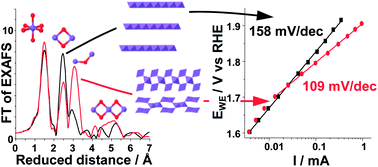Manganese based precious metal-free electrocatalysts for the oxygen evolution reaction (OER) are promising materials for energy storage systems based on dark or photo-coupled water electrolysis, because they are active, inexpensive and of low toxicity. In this work, atomic scale structure–activity relationships of two different nano-structured manganese oxides, MnOx, are established using a combination of X-ray absorption, diffraction and electrochemistry. Prepared by chemical symproportionation (s-MnOx) and impregnation (i-MnOx), the s-MnOx catalyst consisted of a layered structure similar to δ-MnO2 while the i-MnOx catalyst displayed a mixture of tunnelled, 3D cross-linked β- and defective γ-MnO2 structures. During electrocatalytic oxygen evolution the structural motifs of both MnOx remain largely unchanged, but the oxidation state of Mn increases from 3.5 to 3.9–4. Kinetic parameters of the electrocatalytic oxygen evolution reaction were extracted using Tafel slope analysis and pH titration experiment, and the role of the protons abstracted was analyzed. The study reveals fundamental differences of general importance in the catalytic activity between layered and cross-linked structures. The exclusive presence of di-μ-oxo-bridged Mn ions in the layered structure is coupled to a pronounced redox and charge capacity behaviour. This ensured efficient use of surface and bulk active sites, and resulted in a relatively large Tafel slope. Consequently, the intrinsic OER activity is especially high in s-MnOx. In contrast, 3D cross-linked structures with both mono- and di-μ-oxo-bridged Mn ions resulted in lower intrinsic activity but smaller Tafel slope, and thus favourable activity at technological water-splitting rates. The insights from this comparative study will provide guidance in the structural design and optimization of other non precious metal oxide OER catalysts.

You have access to this article
 Please wait while we load your content...
Something went wrong. Try again?
Please wait while we load your content...
Something went wrong. Try again?


 Please wait while we load your content...
Please wait while we load your content...